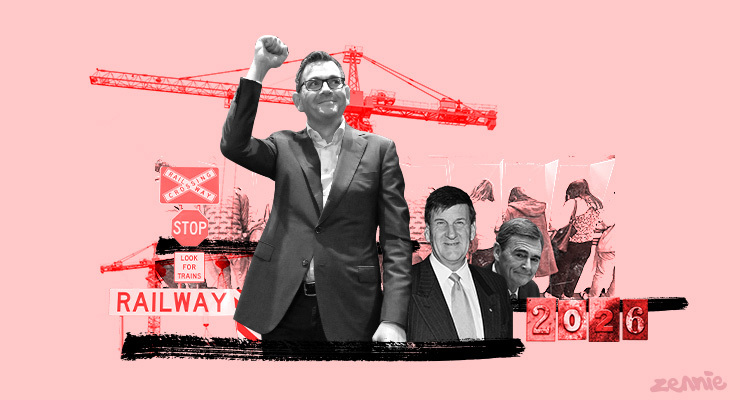
Outside of a right-wing media ecosystem whose irrelevance was exposed by the result, discourse following the Victorian election has naturally been dominated by Labor’s triumph over its political, media and cultural adversaries.
This is entirely appropriate, but the government should take care to view the result through a self-critical lens, lest it succumbs to a pride that might be followed by a fall in 2026, when it will face the even greater challenge of asking voters for a fourth term. Party hardheads with a sense of history will have noted parallels between the result and those that preceded the ultimate defeats of the Kennett government in 1999 and the Brumby government in 2010.
Jeff Kennett’s already healthy ego was given a further charge by the result of the 1996 election, when Labor gained only a net two seats after the shellacking it copped four years earlier. This belied an overall swing to Labor of 3% that was concentrated in regional areas, providing a foretaste of where his government would come unstuck three years later.
The scale of Daniel Andrews’ win is also similar to Steve Bracks’ in 2006, which at the time appeared to confirm Labor as modern Victoria’s natural party of government — a reasonable contention in the long term, but not one that saved them in 2010.
The statewide swing against Labor on Saturday looks to have been in excess of 3%, which would have resulted in six to eight seats falling to the Liberals had it been perfectly uniform, as compared with a likely loss of only two.
Happily for Labor, its vote more than held up across the eastern suburbs and fell only modestly in the “sandbelt” seats of Melbourne’s bayside south-east. The former area has been the focal point of Melbourne’s Chinese immigration influx, who turned heavily against the Liberals at the federal election in May, costing them the seat of Chisholm and bringing them to the brink in a number of seats they were not expecting to lose.
In the latter, Labor maintains margins approaching double digits in a string of seats that have historically been regarded as a collective bellwether, having been swept up by the Liberals in 2010 before returning to Labor when Andrews came to power in 2014.
The catch is that both areas have done well out of the Andrews government’s infrastructure projects, the former being the target of the first stage of the contentious Suburban Rail Loop, and the latter the main beneficiary of the government’s show-stopping program to rid the suburbs of level crossings.
The price paid for the prioritisation of these areas has been neglect in Labor’s heartlands of Melbourne’s north and west, which was the subject of grumblings throughout the campaign from locally interested party sources.
Ground zero for such concerns was the rapidly developing seat of Melton on Melbourne’s western edge, where local discontent has been brewing over slow progress towards a new hospital and connection to the metropolitan rail network.
The fact that independent challenges in such seats failed to meet expectations encouraged by a media hungry for anti-Labor narratives should not lull the government into a false sense of security.
Labor’s vote share in Melton is 12% below where it was in 2014, and there were double-digit swings at this election in Broadmeadows, Greenvale, Mill Park, Thomastown and Yan Yean in Melbourne’s north, and Kororoit, St Albans and Sydenham in the west.
As with the eastern suburbs, these results echoed the federal election, where Labor copped swings of 7.2% and 6.1% in the northern Melbourne seats of Calwell and Scullin, which were very likely influenced by discontent with the state government.
For the time being at least, Labor’s existing buffers in such seats have been handily sufficient to stave off defeat.
But in an age when neither major party can count on the support of more than a third of the electorate, it is no idle platitude to assert that there is no longer such a thing as a safe seat — as the Liberals discovered to their cost at the hands of the teal independents in May.
Should Victorian Labor be worried about 2026? Does it need to pay more attention to its traditional heartland? Let us know your thoughts by writing to letters@crikey.com.au. Please include your full name to be considered for publication. We reserve the right to edit for length and clarity.








I think the ALP needs to be “alert not alarmed.” 🙂
If hypothetically we leave aside the pandemic and lockdowns there is some basis to the perception (whether reality or not is a matter of opinion) of Andrews’ autocratic style.
So either make genuine changes to that style or hand over to Jacinta Allen before 2026 for a change of style could be the answer to stop those swings against ALP.
Winning a fourth term has to be harder than a second or third. Probably even harder than winning a first term. Entropy, complacency, corruption. Internal critics will not be enough – the six or so votes needed in the upper house, if treated with respect, may be the key. Also good on-the-ground ears throughout the branches. Will they be up to it?
Bowe is basically correct, as usual. But, Liberal votes lost here were lost, going off to independents or ineffectual rump ratbag groups. ALP votes “lost” were loaned out to greens and independents in ways which boomeranged or crashlanded harmlessly. In a age of toleration for “reffo” types, for gays and queers, for assisted dying, for easing of penalties for personal drug use, the mediaeval mad monkery of the Credlin Kroger types, the warrior misfits of evangelism, the self centred freedom for only me types, is ILLIBERAL.
Three terms is enough for any party.
Normally so. But the alternative throughout Australia is generally abysmal.
It’s time will start playing a bigger part. Though one wonders if Andrew’s will step down before the next election, giving the veneer of a refresh.